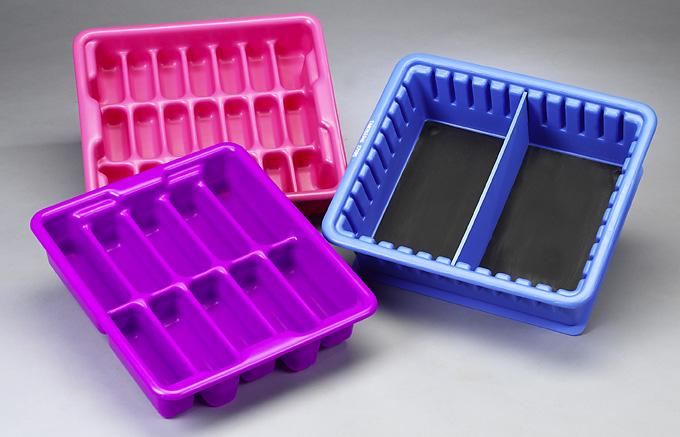Unraveling the Future Landscape of the Thermoformed Plastics Industry

Thermoformed Plastics: An Essential Part of Modern Packaging
Introduction to Thermoforming
Thermoforming is a plastic forming process where a plastic sheet is heated to a pliable forming temperature, formed to a specific shape in a mold, and trimmed to create a usable product. The key advantages of thermoforming are its ability to produce complex, high-volume shapes in a single continuous process. Some common thermoformed products include food and medical packaging, containers, automotive interior parts, signs and displays.
Sheet Forming Process
In the thermoforming process, plastic sheet material such as PVC, polystyrene, polyethylene, polypropylene, or acrylic is used. The sheet is first heated to high temperature using infrared heaters until it softens and sag. It is then placed over a matched mold cavity and a vacuum is applied from below, forcing the softened sheet tightly against the mold surface. The sheet cools and hardens to the exact shape of the mold profile before being trimmed and ejected. This allows consistent high-volume production of parts with complex 3D shapes.
Common Thermoforming Materials
The most widely used plastic sheets for thermoforming include polystyrene (PS), polypropylene (PP), polyethylene terephthalate (PET) and polyethylene (PE). Each has their own advantages for different applications:
- Polystyrene is lightweight, inexpensive and readily thermoformable. It is commonly used for foodservice containers and packaging.
- Polypropylene has good chemical and temperature resistance. It is often used in food packaging where heating or freezing is involved.
- PET has excellent clarity, stiffness and moisture barrier properties. It is a preferred material for packaging liquids and foods that require visibility.
- Polyethylene is flexible, tough and cheap. Low density PE is commonly thermoformed into shopping bags, trash can liners while high density PE is used for storage containers and automotive parts.
Applications in Food Packaging
Thermoformed plastics play a crucial role in food packaging where packaging needs to be inexpensive yet functional. Common examples include:
- Meat and produce trays - Polystyrene and polypropylene trays of varying sizes are used in supermarkets for packaging sliced meats, cheeses, fruits and vegetables.
- Cereal liner bags - PET and polypropylene sheets are thermoformed into shape-retaining liner bags that fit inside cereal boxes for moisture and freshness protection.
- Egg cartons - Recyclable polystyrene cartons thermoformed into compartments provide protection for transporting eggs.
- Takeout containers - Disposable clamshell containers made from polystyrene or polypropylene are used ubiquitously for serving and carrying out foods from restaurants and fast food outlets.
- Yogurt and snack cups - PET, polypropylene or polylactic acid (PLA) cups are thermoformed for packaging single-serve yogurt, pudding, juice boxes and snack products.
Medical Applications
In the medical industry, thermoformed plastics play an important role in single-use, disposable devices and packaging applications due to their ability to produce high detail, precise parts economically. Common uses include:
- Medical trays - For organizing surgical tools and instruments in operating rooms.
- Blister packs - For packaging pills, tablets, contact lenses and other small medical items in tamper-proof sheets.
- IV baggies - Thermoformed from flexible PVC sheets into intravenous fluid bags.
- Procedure kits - Assembly of components like scalpels and clamps into sterile procedure-specific kits.
- Face masks - Expanding use of thermoformed PETG and polypropylene masks during COVID-19 pandemic.
Sustainability Considerations
As concerns grow around plastic waste and sustainability, thermoformers are increasingly focusing on use of recycled resins and design of packaging for recyclability. Some key trends include:
- Incorporation of post-consumer recycled (PCR) content in packaging to promote circular economy.
- Mono-material thermoformed containers made of PET, PP or PE for improved sorting and recycling.
- Reduced plastic thickness and shaping features to minimize material usage.
- Compostable thermoformed products made from PLA or paper for composting or recycling streams.
The future of thermoformed plastic packaging lies in sustainable design, efficient processes, and alternative biodegradable resins to balance performance, cost and environmental impact. Continued innovation is ensuring this technology remains relevant in a changing regulatory
landscape.
In Summary, thermoformed plastics have become integral components of modern packaging solutions, offering versatility, durability, and cost-effectiveness. This manufacturing process involves heating plastic sheets and molding them into various shapes to create packaging for a wide range of products. From food and beverages to consumer goods and medical supplies, blow moulding plastics provide lightweight and customizable packaging options that protect products during storage and transportation. Their ability to conform to specific shapes and sizes, along with their transparency and barrier properties, make them ideal for showcasing and preserving goods while reducing packaging waste. As a vital element in modern packaging, blow moulding plastics continue to play a crucial role in meeting the evolving needs of industries worldwide.
- Art
- Causes
- Crafts
- Dance
- Drinks
- Film
- Fitness
- Food
- Jeux
- Gardening
- Health
- Domicile
- Literature
- Music
- Networking
- Autre
- Party
- Religion
- Shopping
- Sports
- Theater
- Wellness
- IT, Cloud, Software and Technology


